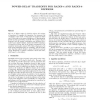Free Online Productivity Tools
i2Speak
i2Symbol
i2OCR
iTex2Img
iWeb2Print
iWeb2Shot
i2Type
iPdf2Split
iPdf2Merge
i2Bopomofo
i2Arabic
i2Style
i2Image
i2PDF
iLatex2Rtf
Sci2ools
ISLPED
1998
ACM
1998
ACM
Power-delay tradeoffs for radix-4 and radix-8 dividers
The use of higher radices in division reduces the number of iterations to complete the operation, but increases the complexity of the circuit. In this paper we explore the in uence of the radix on the power dissipation of a oating-point divider and the power-delay tradeo s. We compare the performance and the energy consumption per operation for a radix-4 and a radix-8 divider, realized in CMOS technology. A reduction of about 40 in the energy consumption is obtained for both radices
about 70 if low-voltage gates, for dual voltage implementation, are available
. Also the results show that the radix-8 divider is about 20 faster and the energy dissipated to perform a division is about the same, with respect to the radix-4.
| Added | 05 Aug 2010 |
| Updated | 05 Aug 2010 |
| Type | Conference |
| Year | 1998 |
| Where | ISLPED |
| Authors | Alberto Nannarelli, Tomás Lang |
Comments (0)

